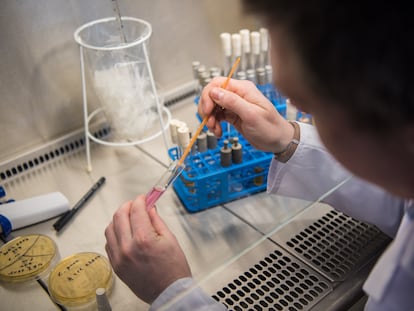Handwashing, disinfection, and vaccines could prevent 750,000 annual superbug deaths
Most of these preventable deaths occur in low- and middle-income countries, according to a series in ‘The Lancet’ in which scientists flag up the need for reducing inappropriate antibiotic use in humans by 20% and in animals by 30% in the next five years

An Indian university student suffering from tuberculosis, a Kenyan veterinarian hospitalized for months with an infection after surgery, an American gymnast suffering from staphylococcus, and a baby in Indonesia with respiratory problems, vomiting and diarrhea. All have suffered from the so-called “silent pandemic,” as antibiotic-resistant bacteria are described by the World Health Organization (WHO).
These antibiotic-resistant bacteria are present in almost five million deaths annually, even when another cause of death is recorded. They are also the direct cause of 1.27 million deaths. Sub-Saharan Africa and South Asia are the regions with the highest incidence of fatality attributed to antibiotic resistance, with more than 20 per 100,000 inhabitants, compared to an average of 13 in developed countries.
Some 750,000 deaths associated with superbugs could be avoided each year, especially in low- and middle-income countries, by improving measures such as handwashing and disinfection in healthcare settings, access to clean water and a wider availability of childhood vaccines. This is one of the conclusions of a series of four articles recently published in the scientific journal The Lancet on “sustainable access to effective antibiotics.” The authors — 38 experts in antimicrobial resistance and global health from around the world — warn that this is a growing problem that will cause an increasing number of deaths if it is not tackled; a 2016 study estimated that by 2050 it would cause 10 million deaths per year, the majority of which will occur in the world’s most vulnerable groups.
“The small pool of effective antibiotics has shrunk, especially in resource-poor settings, and the very young, very old, and severely ill are especially susceptible to resistant infections,” states the first of the four reports, which focuses on the global scope of the problem and how to measure it. Antibiotic-resistant bacteria “pose a major obstacle to the achievement of the Sustainable Development Goals, including the goals of neonatal survival, progress in healthy aging, and poverty alleviation.”
In the absence of any action, more people will become infected and die from resistant infections, and treatments will become more expensive and potentially inaccessible to people in the most resource-limited settings.Iruka Okeke, professor of Pharmaceutical Microbiology, University of Ibadan, Nigeria
One of the co-authors, Iruka Okeke, Professor of Pharmaceutical Microbiology at the University of Ibadan in Nigeria, describes the scenario if action is not taken urgently: “In the absence of any action, more people will become infected and die from resistant infections,” she says. “Resistance to drugs of last resort could be more than twice as prevalent in 2035 as in 2005. Treatments will become more expensive and potentially inaccessible to people in the most resource-limited settings.”
These resource-limited environments, which in turn have a higher incidence of infectious diseases and lower healthcare capacity, are precisely “those that can benefit most from containing antimicrobial resistance” through existing tools, explains Okeke. By improving the prevention and control of infections in low- and middle-income countries, 337,000 deaths per year associated with resistant bacteria acquired in healthcare centers — one of the most frequent forms of contagion — could be avoided, out of the current 1.7 million deaths per year in these countries.
Prevention and control involves greater adherence to hygiene standards, mainly in terms of handwashing by healthcare personnel, and improvements in environmental cleanliness, antiseptic techniques and disinfection and sterilization measures, to avoid infections reaching the patient through catheters, ventilators, and surgery. To achieve this reduction in deaths, the prevention and control standards of these countries would have to be aligned with those of high-income countries, according to the mathematical model developed by the study’s authors and discussed in the second article of the series.
Triple goal
The study also estimates how many deaths could be avoided in these countries through universal access to water, sanitation and hygiene services, which would prevent 247,800 deaths associated with antimicrobial resistance, although the article warns that to achieve this figure, higher quality interventions are required than those currently proposed.
The other strategy is achieving universal access to pediatric vaccines, which would prevent 181,500 deaths, both by directly preventing resistant infections and by reducing antibiotic consumption, according to the analysis.
Okeke believes that these interventions, which would reduce the incidence of deaths associated with resistant bacteria in developing countries by 18%, “are realistic, even in resource-constrained settings.” The authors of The Lancet series aim for a threefold global goal by 2030, set out in the fourth of the articles: to reduce antimicrobial resistance by 10%, to reduce inappropriate use of antibiotics in humans by 20%, and inappropriate use in animals by 30%. To this end, they call for prioritizing the actions proposed at the U.N. General Assembly to be held in September.
According to the study, “Our findings indicate that reducing the global incidence of antimicrobial resistance by 10% by 2030 is achievable with existing interventions. Our results should guide investments in public health interventions toward those with the greatest potential to reduce it.”
These actions are not, however, enough to ensure that everyone in need has access to affordable and effective medicines. “The growing number of bacterial infections worldwide that do not respond to available antibiotics indicates the need to invest in — and ensure access to — new antibiotics, vaccines, and diagnostics,” the third article in the series points out.
Ensuring access
“The traditional model of drug development, which relies on substantial revenues to motivate investment, is no longer economically viable without incentives,” according to the study. “Moreover, drugs developed through these mechanisms are unlikely to be affordable for all patients who need them, especially in low- and middle-income countries.” The authors advocate “new public financing models based on public-private partnerships” to support investment in antibiotics and novel alternatives while reducing costs for patients.
Nour Shamas, a 36-year-old Lebanese clinical pharmacist specializing in infectious diseases, is aware of the problem, not only on account of her work, but also because a few years ago, her mother, now 69, contracted a resistant and recurrent urinary tract infection after being hospitalized for spinal surgery. Shamas appreciates the measures proposed in the articles in The Lancet, but points out that although they seem very simple, “each has its own difficulty. For example, handwashing: even if clean water and soap are available, there may not be enough nurses in the hospital, so those there are badly overstretched,” she points out. “Sometimes they don’t wash their hands, sometimes they wash their hands, but they don’t take 30 seconds to scrub. Or maybe they forget because they go from one patient to another. And sometimes people get tired and burned out.”
Talking from Riyadh, where she works, Shamas says she is privileged to be able to afford the expensive antibiotics and tests that her mother still needs every two or three months in Lebanon — a country in crisis in which medicines are hard to come by even if you can afford them. “We paid for lab tests to check what kind of resistance she had in order to identify the best antibiotic to treat the initial episode,” she explains. Now, every time the infection recurs, her mother has to have another test to figure out which antibiotic to use. “Often, she starts with one and, after two or three days, has to switch to another.”
Shamas belongs to a WHO working group, made up of 12 antimicrobial resistance survivors or family members. The group has posted a comment responding to The Lancet’s articles, which calls “on all those working on antimicrobial resistance to consider the patient’s voice in their work and incorporate a people-centered approach. Antimicrobial resistance transcends borders and visa requirements and conflict zones. It can affect anyone, regardless of wealth, race or region around the world,” it points out.
Sign up for our weekly newsletter to get more English-language news coverage from EL PAÍS USA Edition
Tu suscripción se está usando en otro dispositivo
¿Quieres añadir otro usuario a tu suscripción?
Si continúas leyendo en este dispositivo, no se podrá leer en el otro.
FlechaTu suscripción se está usando en otro dispositivo y solo puedes acceder a EL PAÍS desde un dispositivo a la vez.
Si quieres compartir tu cuenta, cambia tu suscripción a la modalidad Premium, así podrás añadir otro usuario. Cada uno accederá con su propia cuenta de email, lo que os permitirá personalizar vuestra experiencia en EL PAÍS.
¿Tienes una suscripción de empresa? Accede aquí para contratar más cuentas.
En el caso de no saber quién está usando tu cuenta, te recomendamos cambiar tu contraseña aquí.
Si decides continuar compartiendo tu cuenta, este mensaje se mostrará en tu dispositivo y en el de la otra persona que está usando tu cuenta de forma indefinida, afectando a tu experiencia de lectura. Puedes consultar aquí los términos y condiciones de la suscripción digital.
More information
Archived In
Últimas noticias
The new victims of the Republican war on Obamacare: Millions hit by soaring health insurance premiums
A country divided on migrant rights: Some US states expand protections while others restrict them
Venezuela authorizes the release of another 87 political prisoners
There is as much life left to discover on planet Earth as that which is already known
Most viewed
- David King, chemist: ‘There are scientists studying how to cool the planet; nobody should stop these experiments from happening’
- Reinhard Genzel, Nobel laureate in physics: ‘One-minute videos will never give you the truth’
- Oona Chaplin: ‘I told James Cameron that I was living in a treehouse and starting a permaculture project with a friend’
- Sinaloa Cartel war is taking its toll on Los Chapitos
- The Interoceanic Train, the Mexican alternative to the Panama Canal










































